Dilophosaur fans of multiple varieties get the best deal with this pair of charmingly well-constructed plush predators of semi-anonymous origin.
The realm of gray-market (dinosaur) toys is full of, well, gray areas to be cautiously navigated; in an online age it’s especially easy to get lost in a malaise of sketchy knockoffs and bootleg toys from unknown sources. Amidst the hazards and illegal products, however, there are some legitimately unique and interesting items to be found. This is true not only for plastic toys, but plush toys as well; I happened across an intriguing pair of stuffed Dilophosaurus toys one day while browsing the internet for hidden “gems” of dino merchandise. Stuffed dinosaurs aren’t exactly rare, but they’re not especially common either. A genus like Dilophosaurus falls just outside the range of the most mainstream dinosaurs to typically get attention, so for someone to produce not one, but a pair of plushies for this ornately-decorated Jurassic theropod struck me as rather special.

The stuffed Dilophosaurus toy pair is completely devoid of sewn-in tags; the only descriptor is a punch tag attributed to the brand “Miss Bloom”, with very basic fabric and filler information on the back (100% plush, PP Cotton). I have yet to find any other leads on this “Miss Bloom” corporation, so I suspect it’s a throwaway name for whatever true factory of origin distributes these toys to sellers.
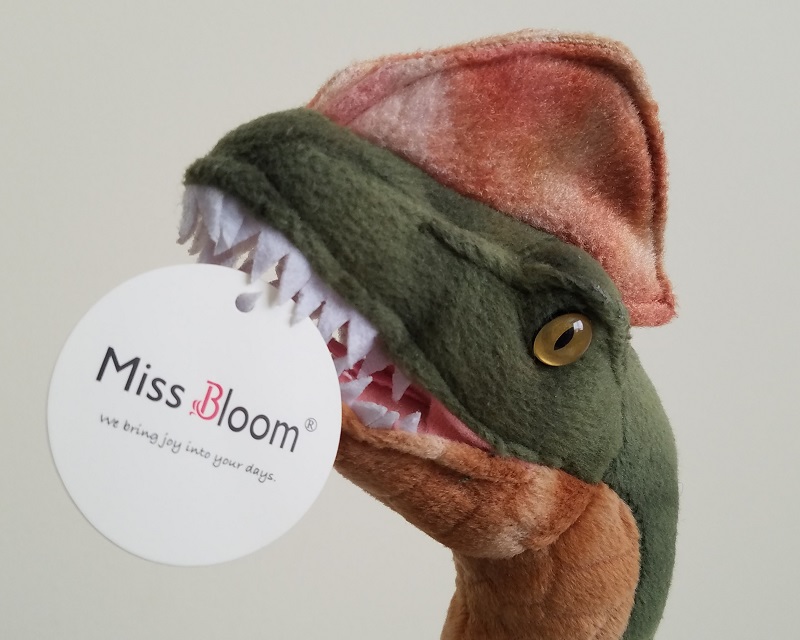
Each Dilophosaurus is a sizeable stuffed animal, measuring 51 cm (20 in) long from nose to tail, and 37 cm (14.5 in) tall from crest to toe. Each figure is posed in the old-fashioned tripod stance, with arms and head tilted back as if the animal was rearing up. Obviously the figures aren’t designed for scientific accuracy; but I don’t think it’s unreasonable to say Dilophosaurus could have assumed this sort of position for display or other behavioral purposes. The body’s anatomy is nondescript and gently round, and the hands and feet are similarly simple, bearing three digits each. the hands are posed in the stereotypical pronated pose; when combined with the raised stance, it ends up making the dinosaurs almost resemble a begging puppy more than an imposing predator. Oh, well – again, this IS a stuffed toy.
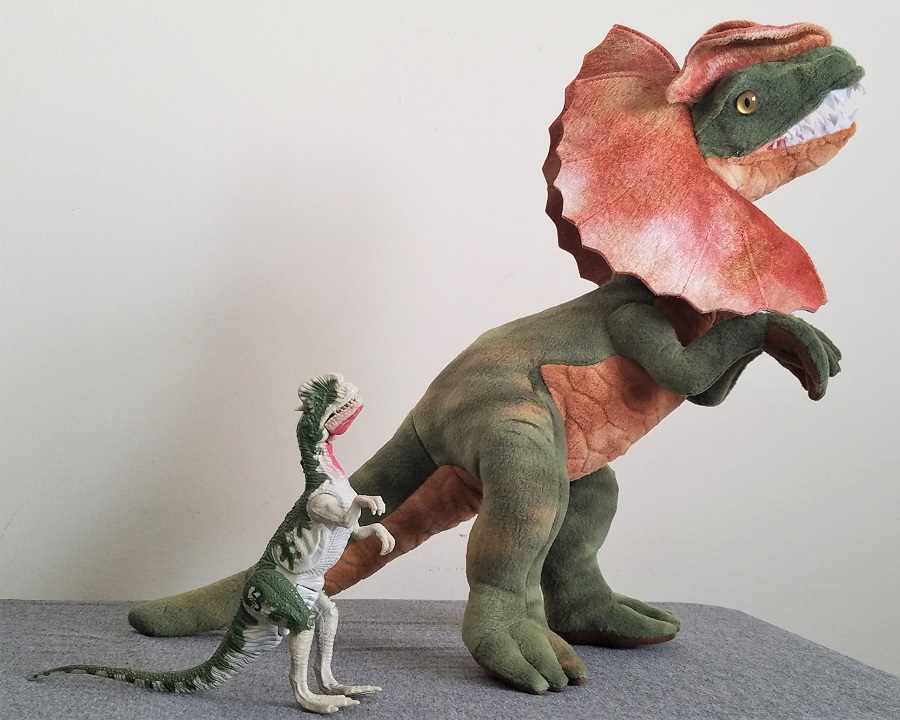
More accurately rendered than the limbs is the head of each figure, which features the most recognizable traits of the animal. The iconic double crests which give Dilophosaurus its name are present in their classic, shell-like rounded form, with the little “tail” or “canal” jutting back behind the eyes. The crests are sewn on top of the head as separate fabric pieces, in line with traditional imagery for the dinosaur. I have no idea when these toys were first designed, so there’s no telling if these were conceived before Marsh et. al. 2020 brought striking new factors to the likely appearance of the crests, or if this was simply an oversight on the toy designer’s part. Depending on the individual toy, the crests may tend to sit close to one another or stick out in a more spread manner; one can attempt fiddling with the crests to achieve the ideal positioning (temporarily – they’re still just fabric).

Other skull traits include the notch in the upper jaw, known as a subnarial gap or “kink”, which is visible on each toy; the gap isn’t as prominently displayed as in some reconstructions, however, and there are variations to the gap in between the two figures, likely as production quirks. Ironically, a more subtle kink may prove to be a more realistic trait of the animal; however the line of teeth does not separate between the premaxilla and the maxilla. These teeth are uniform in size and shape – likely for simplicity of the toy – and run most of the length of the mouth. A small tongue is also present if one pries the jaws open to peek inside. The face also displays widely-spaced orbits, which I’ve noticed on more than one reconstruction including recent art following the Marsh et. al. paper. I’m not sure if this is a guaranteed characteristic of Dilophosaurus, and on these particular toys the eyes are space far enough that from the front the face has a somewhat froggy expression; but I think it’s worth noting there is a precedent for this look in other artwork representing this theropod.
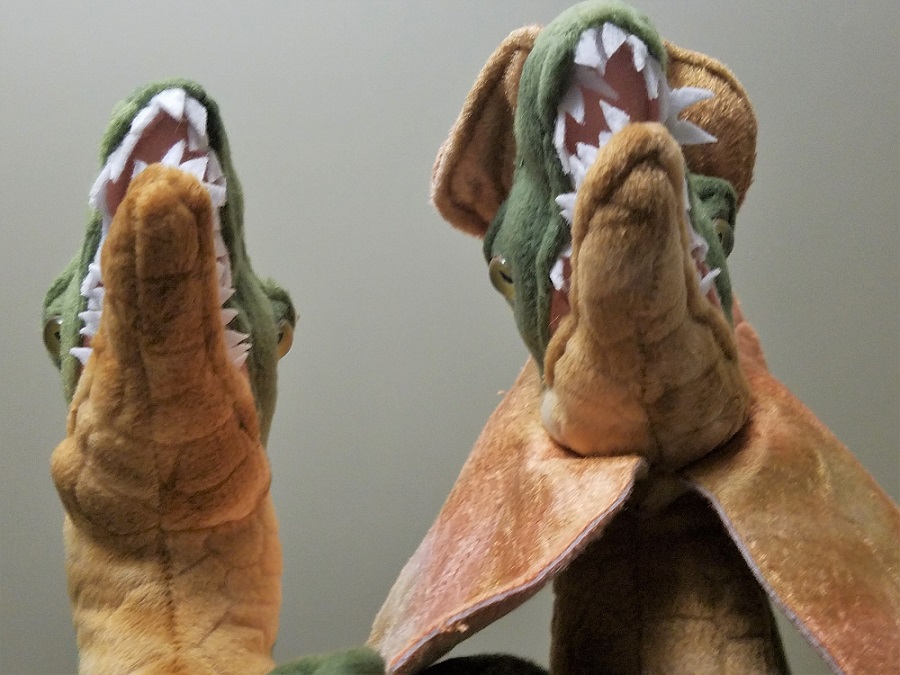
What distinguishes this pair of stuffed toys from each other, besides minor quirks from the manufacturing process, is one additional feature all too familiar to those who know Dilophosaurus’s pop culture history: one toy features a large frill attached behind the head, while the other toy lacks it. The frill is sewn in two separate pieces, left and right, and has a subtle scale texture to the fabric. The frills can be played with to flap back and forth like large ears – although they don’t really hold any pose, much less fold up to hide on the neck. While frills on Dilophosaurus are well overdone as a pop culture trend, I honestly like the decision to sell this plush in both variants, allowing Jurassic Park fans (who else?) and paleontology fans to choose between their preferred likeness of the animal – or, in my case, to buy both as a pair for comparison.
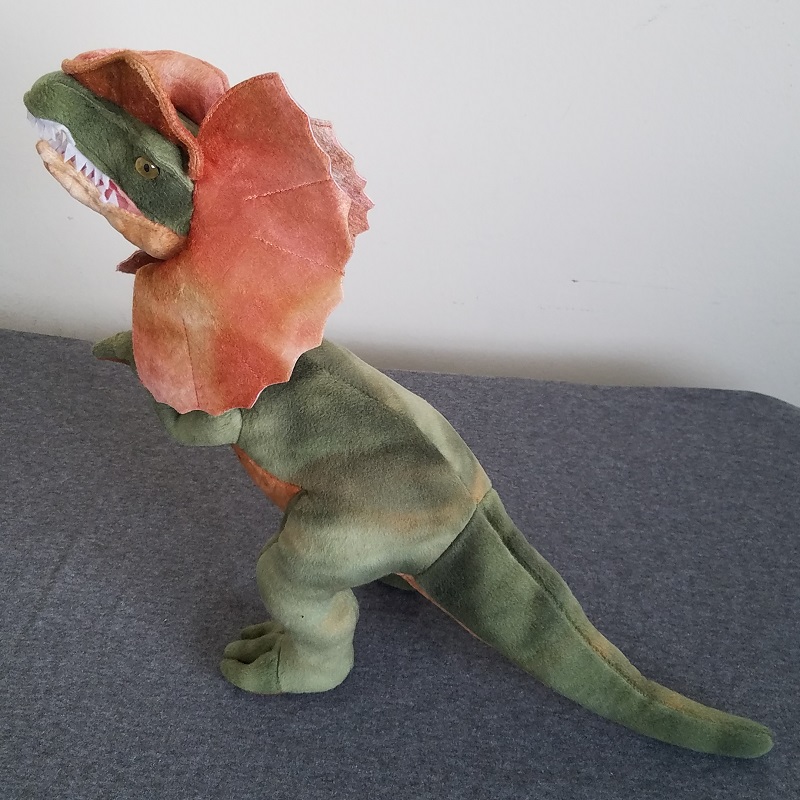
Color patterns are fairly simple, but attractive on these toys; most of the body is covered in an irregular green gradient pattern, with another gradient pattern of light orange-brown on the underbelly. A cragged texture is applied on the underside to emulate a vaguely scaly appearance. The orange-brown hue is also utilized for the crests and frill, which contrast nicely with the green head. The bottoms of the hands and feet are a solid earthy brown, and The eyes are plastic, and feature catlike slit pupils, with striking yellow irises that give the toy dinosaurs a little of that classic sinister predator look. As previously mentioned, there are no tags attached anywhere on the body; only a few seam lines along the back and in between body segments obviously betray the plush nature of the toy.
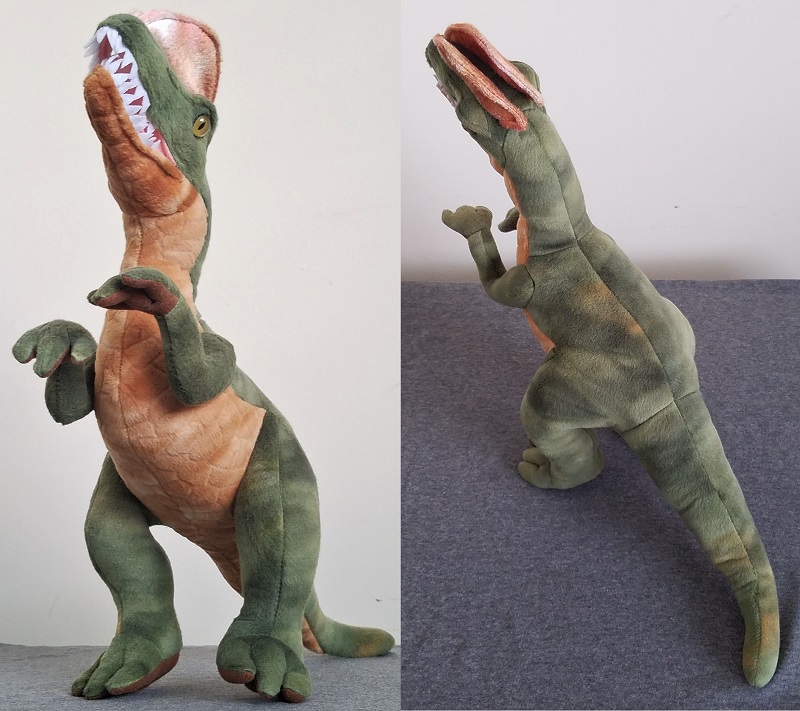
I don’t typically look for strict accuracy in stuffed animals, understandably; but this Dilophosaurus pair from “Miss Bloom” are quite well made for what they are. The selection of frilled and un-frilled versions is a nice touch to please dino-fans of different varieties, and the quality of each toy should be good for kids and collectors alike to enjoy. You can buy one or both versions for yourself through assorted sellers on AliExpress and eBay.
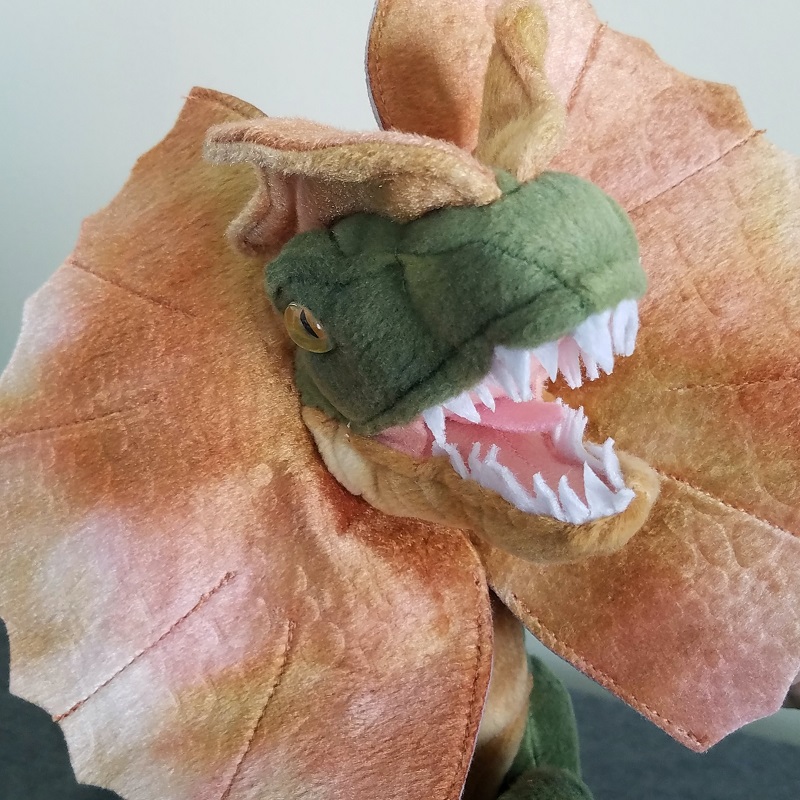
Support the Dinosaur Toy Blog by making dino-purchases through these links to Ebay and Amazon. Disclaimer: links to Ebay.com and Amazon.com on the Dinosaur Toy Blog are often affiliate links, when you make purchases through these links we may make a commission

I believe the company that made these is called Gage Beasley.